Around 90% of birds are monogamous
[1], which means they only have one mate at a time. However, although monogamous, most of these birds will change their partner in every breeding season. And one great example is the orioles. But, do orioles mate for life?Keep reading to learn more…
Oriole birds don’t mate for life. They are, however, monogamous, but their partners will change in every breeding season.
In this article, we’re going to dive deeper into how orioles mate, discussing their mating habits and nesting behavior. So, if you’re curious to know more about how these birds reproduce, read on…
About The Oriole Birds
Orioles are mainly known for their orange and black plumage, where male birds are brighter than female birds. They are medium to long-distance migratory birds, breeding primarily in the US while wintering south in Mexico to South America.
There are seven most common oriole species found in North America:
- Orchard Oriole
- Audubon’s Oriole
- Altamira Oriole
- Baltimore Oriole
- Hooded Oriole
- Bullock’s Oriole
- Scott’s Oriole
In the table below, we show a summary on each bird’s mating behavior:
| Type of Orile Bird | Oriole Mating Behavior |
|---|---|
| Orchard Oriole | Monogamous within each breeding season |
| Audubon’s Oriole | Monogamous but pairs sometimes remain together until the non-breeding season |
| Altamira Oriole | Monogamous all-year-round |
| Baltimore Oriole | Monogamous within each breeding season |
| Hooded Oriole | Assumed to be monogamous within each breeding season |
| Bullock’s Oriole | Monogamous within each breeding season |
| Scott’s Oriole | Monogamous within each breeding season |
By just simply looking at the table above, we can immediately see that orioles don’t mate for life.
Most of them just stay together for one breeding season, while some stay together for a year. But that’s really it.
Below, we’ll discuss how these birds reproduce in general.
Oriole Mating Habits
Let’s start with the birds’ mating habits.
Orioles usually arrive around early April to late May in their breeding grounds, which are mainly found in the northern and central parts of America.
The male birds arrive before the females to start claiming territories, usually around 2-3 days before. This is why you’ll hear them around early spring singing on top of treetops to attract a mate. Most of the time, they’ll just keep on singing until, eventually, a female bird comes to them.
These birds, however, tend to rest at night. So, even if they haven’t found a mate yet, they won’t sing at night and will just continue singing the next day until they find a bird to pair with.
When the birds form a couple, the singing will stop. This means that whenever you hear orioles singing in the middle of the breeding season, chances are, these birds are unmated.
Oriole Nesting Behavior
When the male and female birds are paired up, the female will start searching for a nesting site within the male bird’s territory.
These birds mainly prefer leafy deciduous trees, and their most common choice is the American Elm. But of course, they also nest in other trees like maples and cottonwoods. After that, the female bird builds the nest while the male bird defends the territory.
Orioles are known for their nest-building skill. With their nests created at the highest branch of a tree and suspended from the branch’s fork like a net, there’s no wonder that these birds are the architects of the avian kingdom.
If you’re going to think about it, this is hard to do. After all, there’s this risk that the eggs will fall if the nest is not well-made. But these birds make this easy.
The female birds mainly used hundreds of thin fibers, intertwining them together to create a delicate cradle. And although this nest may look fragile, it can carry up to seven eggs and their chicks once the eggs hatch.
Once the eggs hatch, female birds are the ones who usually watch over the young while the male birds protect and feed them. But then, after the nesting season is over, pairs will separate, sometimes leaving the young birds to survive on their own.
Oriole Birds Unique Mating Behavior
Orchard Orioles
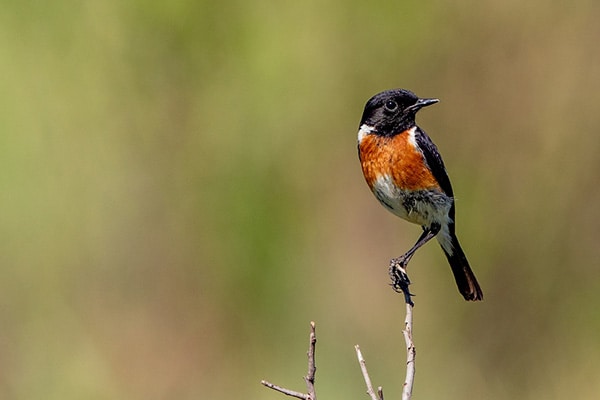
Orchard Orioles don’t stay around their breeding area for so long. A pair will often raise a single brood and then depart mid to late summer.
When it comes to courtship, both male and female Orchard orioles perform bows, seesawing motions, and begging as a form of display. And as these birds are not as territorial as other oriole birds, several pairs often nest in just one tree if it’s a good habitat.
They are often seen with other bird species like Baltimore and Bullock’s Orioles, American Robins, and even Chirping Sparrows.
Audubon’s Orioles
Audubon’s Orioles are probably one oriole species with no known courtship display. When males find a territory, they’ll start singing, waiting for a female bird to find them.
They are not as aggressive as other orioles, and would often resort to hopping, calling, singing, and light chasing when they find another Audubon in their territory. But oftentimes, no clashes are seen frequently.
Female birds are the ones who build the nests, but both sexes share responsibility in incubating the egg.
Unlike other orioles who stay together for the breeding season only, Audubon pairs often stay together even in the wintering grounds. But for some reason, they don’t stay together for another breeding season.
Altamira Orioles
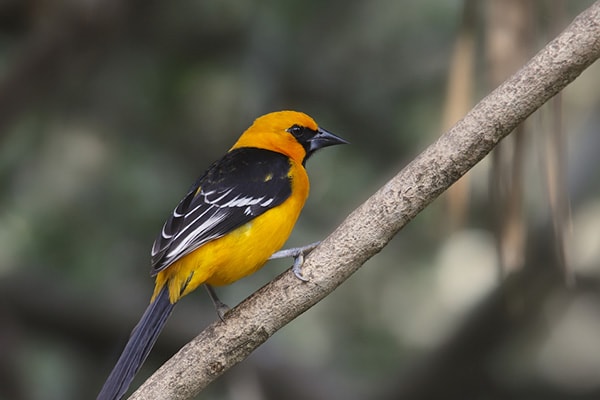
Altamira Orioles are probably the only oriole species that stay together all year round.
Like most birds, only the female Altamira Orioles build the nest and incubate them, while the male bird mainly helps defend the territory and feed the female and their young.
These birds are also observed to be building nests near Great Kiskadees and Tropical Kingbirds so that these aggressive birds will be the ones to drive away predators, which I think is a smart move for these birds.
Baltimore Orioles
Baltimore Orioles are probably the most acrobatic among all oriole species. They hang upside down, snatch insects while in the air, flutter to extend reach, and so much more.
These birds are probably the most common oriole species we’ll find in the backyard. And when you hear an oriole singing, that’s probably most likely the Baltimore Orioles.
When a female bird comes to its territory, the male bird will hop around them while bowing forward and spreading its wings. When the female is receptive, she’ll fan her tail, lower and flutter her wings, and then make a call.
Hooded Orioles
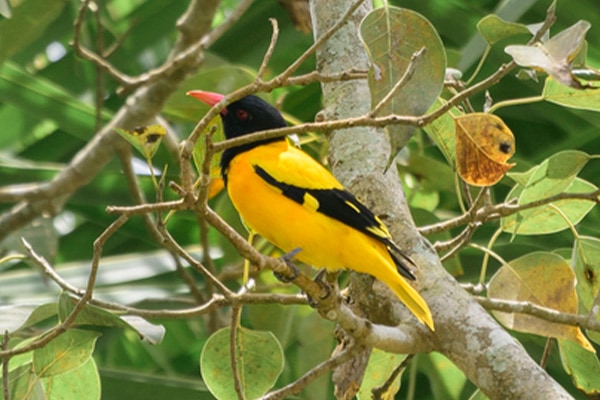
There’s not much known about the Hooded Orioles, but they are assumed to be monogamous within the breeding season, too, just like with the other oriole species.
In courtship, male hooded orioles flutter their wings and move from one branch to another while bowing to the female bird in hopes of getting their attention.
Bullock’s Orioles
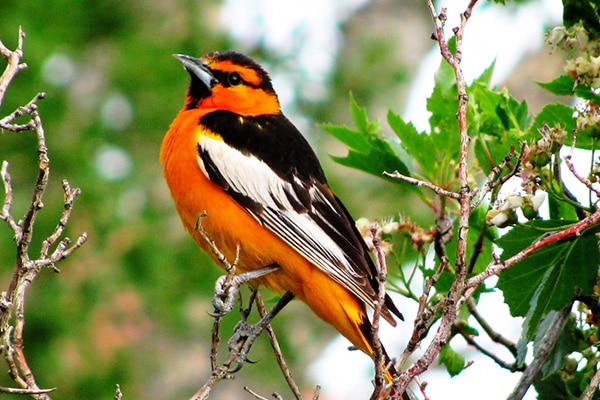
Bullock’s Orioles have a similar courtship display with the Baltimore and Hooded Orioles. They hop from one branch to another while bowing to the female bird every second while singing loudly and spreading their wings to expose their beautiful plumage.
These birds can be very territorial and will chase another male Bullock’s Oriole that tries to enter the territory.
Couple birds will stay paired up throughout the breeding season and even after, but will find new mates once a new breeding season comes. They also protect the nest together from predators instead of just leaving the job for the male bird to handle.
Scott’s Orioles
Scott’s Orioles, like most oriole species, are monogamous birds that pair only within the breeding season. There’s very little known about their courtship display, but once paired, male birds can be very territorial.
Do Orioles Mate For Life FAQs
Are orioles monogamous?
Yes, orioles are monogamous. But unlike other monogamous birds, they only stay together for as short as one breeding season and as long as one year.
Do orioles come back to the same place every year?
It’s common for some oriole species to come back to the same site every year[2]. It could be the same territory, the same tree, or just the same place where their old nest is. However, even if that’s the case, these skilled birds never reuse their old nests.
How many times a year do orioles lay eggs?
Depending on the species, orioles will only lay 1-2 broods each breeding season.
What kind of trees do orioles nest in?
Orioles love staying in leafy deciduous trees, but it can vary depending on the species.
For example:
- Baltimore Orioles love nesting on American Elms the most
- Hooded Orioles hang their nests in the palm, sycamore, or eucalyptus trees
- Orchard Orioles would mostly prefer nesting in maple, ash, cottonwood, elm, and a lot more trees
But all in all, these birds would choose any high tree in an open space and near a water source.
Final Thoughts: Do Orioles Mate For Life
So, do orioles mate for life?
The simplest answer is, no, they don’t. These birds, however, are monogamous for the whole breeding season, with some species even staying together for a year.
It seems that these birds only pair up to increase their population, and once their young are capable of surviving, they go separate ways for winter. Then by the next breeding season, they’ll find another mate.
Sources:
[1] https://web.stanford.edu/group/stanfordbirds/text/essays/Monogamy.html
[2] https://www.wild-bird-watching.com/Baltimore-Oriole.html
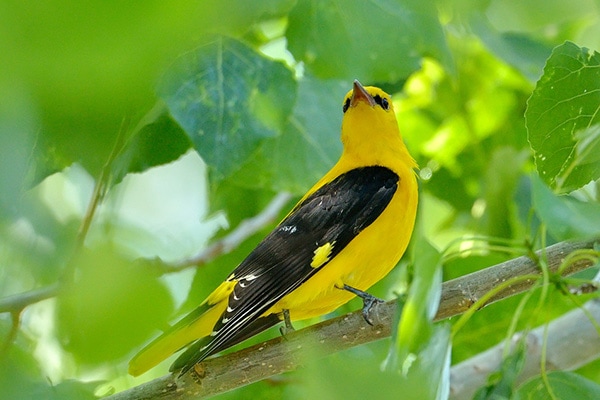
from BirdInformer.com https://ift.tt/3J6wweD

No comments:
Post a Comment